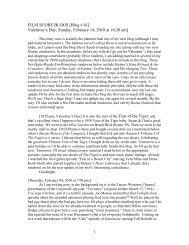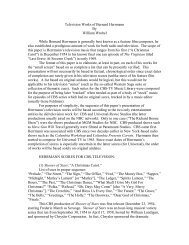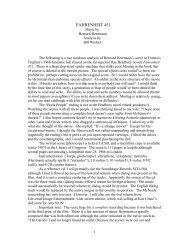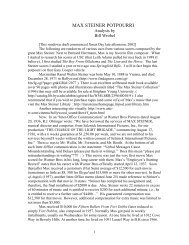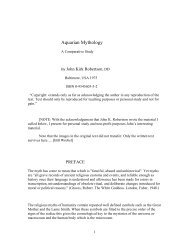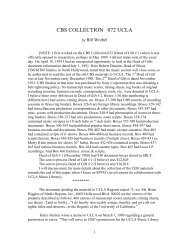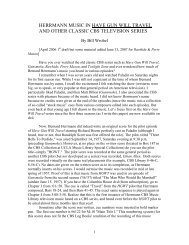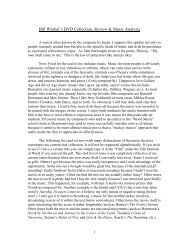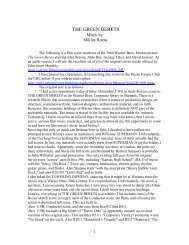OFF-TOPIC BONUS : ASTROLOGY # 2 - Film Score Rundowns
OFF-TOPIC BONUS : ASTROLOGY # 2 - Film Score Rundowns
OFF-TOPIC BONUS : ASTROLOGY # 2 - Film Score Rundowns
Create successful ePaper yourself
Turn your PDF publications into a flip-book with our unique Google optimized e-Paper software.
a 2 nd Persian Empire that cultivated astrology. The last of the Hellenistic Greek<br />
astrologers was around the 6 th or 7 th centuries A.D. Hundreds of years later we find the<br />
earliest Arabic-era astrologers. That astrology was neither Hellenistic nor Hindu, so it’s<br />
probably Persian-based. However, our Western astrology is essentially Arabic-based<br />
astrology (third major Stream or Generation).<br />
The difference between Eastern (Vedic) astrology and Western (Tropical)<br />
astrology is that Western astrology evolves as the ecliptic changes. The constellationbased<br />
and season-based astrology coincided around 200 A.D. Presently the ayanamsa or<br />
difference of degrees between the static Eastern Fixed system and the Western Movable<br />
one is about 23 degrees. The Eastern system made a synthesis with Mesopotamian<br />
astrology but then did not evolve. The ancient western astrology texts were virtually<br />
wiped out in the burning of the Alexandria Library.<br />
So, once again, Mesopotamian astrology appeared to come first into Egypt. Both<br />
Hindu and Greek astrology synthesized Egyptian ideas (eg. whole sign twelve fold<br />
division). The Greeks ran with the concepts and developed them further. The definite<br />
Hindu core (eg., Naksatras) are solely Hindu, but “western” ideas were incorporated<br />
during cultural Empire interchanges.<br />
The end of the general Hellenistic Greek era was about 500 A.D. In 1453<br />
Constantinople is sacked by the Turks. After that much of the Greek material is translated<br />
into the Arabic language. The Greeks are no longer leaders and innovators of<br />
astrological traditions. Probably the greatest blow against Western traditional astrology<br />
was the advent of orthodox, secularized, pervasive Christianity. The esoteric teachings of<br />
ancient astrology were dispensed. Also, another blow to western traditional astrology was<br />
the final burning of the Library of Alexandria by the Moslems in the late 600’s or early<br />
700’s (though they later regretted doing that!). So sympathetic an unorthodox Christians<br />
translated texts into Aramaic or old Syrian or Persian languages, and then the Arabs took<br />
these translations and translated them into Arabic. Ptolemy was translated directly from<br />
the Greek to the Arabic. In effect, the Arabs took over Greek traditions in astrology and<br />
added Persian techniques, etc (eg., the concept of ORBS to astrological aspects which did<br />
not exist in Greek traditions, signs applying and exact to degree). Divisions or houses<br />
survived but more attention was placed to DEGREES. Arabs also WEIGHTED or rated<br />
the dignities (not equal) so that the most important dignity now was considered the<br />
rulership (eg., Mars ruling Aries) followed by exaltation, followed by triplicity rulers, and<br />
then Terms, then Faces (decanates). So, in a sense, our western modern astrology is a<br />
trimmed down version of Arabic-era astrology. The concept of Goddesses (Greeks and<br />
Romans) was abandoned by the Arabs since Islam was a patriarchal system patterned<br />
after Mohammed (Islam is a rigorous monotheism). Catholics still has a loose<br />
montheism since they accepted the Virgin Mary, but then Reformation/Protestantism<br />
came and the importance of the Mary/Feminine principle was thrown out).<br />
*******************************************<br />
SECT (whether a nativity is day/night or diurnal/nocturnal) is one of the most<br />
important issues from ancient/traditional western astrology which had been lost in<br />
modern astrology. The principle is that charts of people born during the day and charts of<br />
people born at night should be read differently. In day/diurnal charts, the Sun is above the<br />
horizon (somewhere within the 7 th thru the 12 th houses) while in night/nocturnal charts,<br />
the Sun is below the horizon (somewhere in the 1 st thru 6 th houses). The planets are then<br />
29




